Effective Cane Sugar Processing: Maximizing Yield and Pureness
Effective Cane Sugar Processing: Maximizing Yield and Pureness
Blog Article
Checking Out the Comprehensive Tips Included in Cane Sugar Processing From Collecting to Refinement
The procedure of cane sugar production incorporates a collection of complex actions, starting with the cautious harvesting of sugarcane and culminating in the improvement stages that make certain the last product meets sector standards. Each phase, from the extraction of juice to the filtration and formation procedures, plays a critical function in determining the quality and character of the sugar.
Collecting Sugarcane
Gathering sugarcane is a vital action in the cane sugar handling chain, as it straight affects the high quality and return of the last item. Proper timing and strategies are necessary throughout this phase to ensure ideal sugar web content and decrease losses. Commonly, sugarcane is gathered when it reaches maturation, normally 12 to 18 months after planting, defined by a high sucrose concentration.

Post-harvest, the sugarcane must be refined swiftly to stop sucrose destruction. Ideally, collected walking cane needs to be transported to refining facilities within 24 hours to maintain sugar top quality. For that reason, efficient logistical planning is critical to keep the honesty of the collected plant throughout the supply chain.
Removal Refine

The crushed cane is subjected to a series of pushing procedures to take full advantage of juice recovery. Generally, warm water is splashed onto the smashed cane, creating a countercurrent flow that helps liquify the sugar while likewise assisting in the extraction procedure. The juice collected from this operation has not only sugar however also various natural compounds and pollutants.

To improve removal performance, some centers may employ diffusion methods, where the sugarcane is taken in warm water, allowing the soluble sugars to diffuse into the liquid. The resulting juice, abundant in sucrose, is then guided to succeeding handling phases, laying the foundation for filtration and improvement. The extraction procedure is hence pivotal in figuring out the high quality and yield of the final sugar item.
Filtration Techniques
The filtration methods employed in walking cane sugar processing are important for transforming the raw juice into a premium sugar item. These approaches mainly aim to get rid of impurities, such as soil, plant materials, and inorganic compounds, which can detrimentally impact the end product's flavor and color.
Among one of the most typical filtration strategies is information. This procedure entails including lime and warm to the raw juice, which helps with the coagulation of contaminations. The resulting precipitate is after that gotten rid of through sedimentation or purification, producing a more clear juice. Additionally, using phosphoric acid can improve the information procedure by additional binding impurities.
One more substantial technique is carbonatation, where co2 is presented to the made here clear juice. This response produces calcium carbonate, which records remaining contaminations and promotes their removal.
Furthermore, activated carbon treatment might be applied to adsorb any type of staying colorants and organic contaminations, ensuring a much more refined product. The combination of these approaches efficiently prepares the sugar juice for succeeding action in the refining process, establishing the stage for the production of top notch cane sugar.
Crystallization Methods
After the filtration phase, the following critical action in walking stick sugar handling entails crystallization methods, which play a crucial role in transforming the cleared up juice into solid sugar. This process generally employs two primary techniques: spontaneous condensation and regulated condensation.
In spontaneous crystallization, supersaturated sugar options are permitted to cool down naturally, leading to the formation of sugar crystals gradually. This technique is less complex however might lead to unequal crystal dimensions and lower purity degrees. On the other hand, regulated formation is a more precise method where focus, seeding, and temperature agents are carefully handled. This technique enables for the uniform growth of sugar crystals and greater pureness.
Throughout crystallization, the clarified juice is focused with dissipation, increasing its sugar content till it gets to supersaturation. When this point is achieved, either method can assist in the crystallization procedure. Cane Sugar Processing. The resultant sugar crystals are after that separated from the staying syrup with centrifugation
Inevitably, the choice of crystallization technique affects the quality, dimension, and purity of the last sugar product, making this action essential in the check it out overall walking stick sugar processing treatment.
Refinement and Packaging
How can the purity and quality of walking stick sugar be additionally boosted after condensation? The improvement procedure plays an essential duty in achieving top quality cane sugar.
Following, the sugar is subjected to a process called centrifugation, where it is spun at high rates to separate the cleansed sugar crystals from the continuing to be liquid. After centrifugation, the sugar is commonly additional fine-tuned with a method called carbonization or phosphatation, which uses turned on carbon or phosphoric acid to eliminate shade and off-flavors.
Once refined, the sugar is dried to achieve the wanted moisture content, ensuring that it stays stable throughout storage space and transport. The final action involves packaging the refined sugar in moisture-proof and impermeable containers to maintain its high quality and protect against contamination. Cane Sugar Processing. Correct product packaging not only extends life span but also promotes very easy handling and distribution, making sure that consumers obtain sugar that meets description the highest possible standards of pureness and high quality
Verdict
The detailed actions entailed in walking cane sugar handling, from the precise harvesting of sugarcane to the elaborate improvement and product packaging phases, highlight the importance of each stage in making certain top notch sugar production. Optimum harvesting strategies, effective removal methods, and rigorous filtration processes jointly contribute to the last item's pureness and security. The crystallization and subsequent packaging methods even more enhance the honesty and life span of the sugar, highlighting the intricacy and precision intrinsic in this vital farming sector.
The process of walking stick sugar production encompasses a collection of intricate actions, beginning with the mindful harvesting of sugarcane and finishing in the refinement phases that ensure the last product meets market requirements. Ideally, collected cane ought to be delivered to refining facilities within 24 hours to maintain sugar quality.In spontaneous condensation, supersaturated sugar solutions are permitted to cool down normally, leading to the development of sugar crystals over time - Cane Sugar Processing. The improvement procedure plays a crucial duty in accomplishing top notch cane sugar.The thorough steps involved in walking stick sugar processing, from the thorough harvesting of sugarcane to the complex improvement and product packaging stages, highlight the significance of each stage in ensuring high-quality sugar manufacturing
Report this page